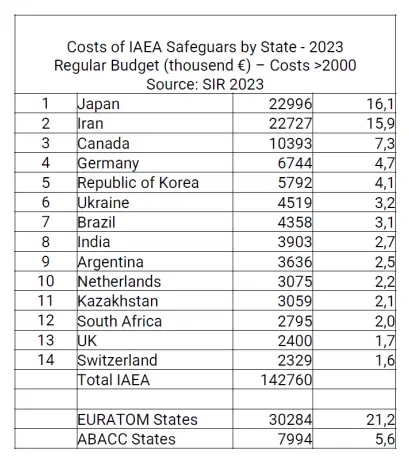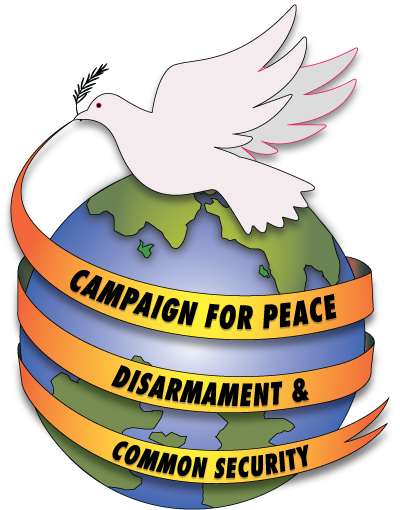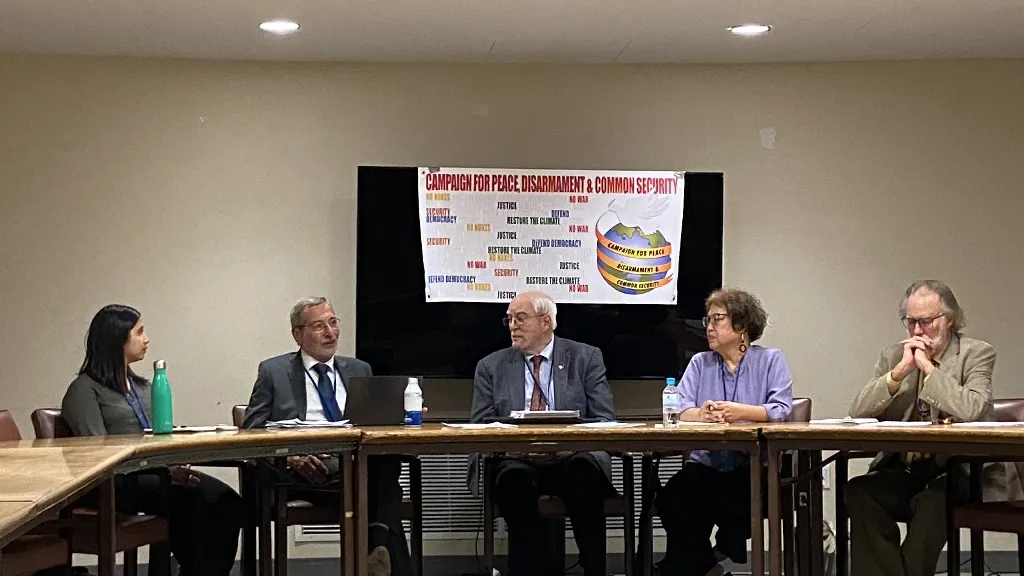We were privileged to play the leading role in organizing the CPDCS/IPB/PANYS “SOME WAY OUT OF HERE: Disarming Nuclear Powers & Preventing Proliferation side event at the United Nations during the Nuclear Nonproliferation Treaty PrepCom. The session featured Yayoi Tsuchda, the Assistant General Secretary of Genduiko, the Japan Council against A- & H- Bombs Dr. Marco Marzo, Secretary General of the the Brazilian-Argentine Agency for Accounting and Control of Nuclear Weapons; and John Burroughs the senior analyst and former Executive Director of the Lawyers Committee on Nuclear Policy
Their talks covered the current state of the increasing nuclear danger, plans for marking August’s 80th anniversary of the Hiroshima and Nagasaki A-bombings, the fascinating history of the tensions and diplomacy that led to the creation of the ground-breaking Brazilian-Argentine Agency for Accounting an d Control of Nuclear Weapons, and a taking stock of the achievements and challenges to the Treaty on Prohibition of Nuclear Weapons.
Watch the video
***
Speech by Dr. Marco Marzo
The international nuclear non-proliferation and safeguards regime is robustly established. Nuclear safeguards play a critical role within the international nuclear non-proliferation framework and are implemented through three types of treaties or agreements based on their scope. The first type includes treaties of international scope, such as the Treaty on the Non-Proliferation of Nuclear Weapons (NPT) and the Treaty on the Prohibition of Nuclear Weapons (TPNW). Under these treaties, the International Atomic Energy Agency (IAEA) is tasked with the application of its safeguards system. The second type involves regional treaties, specifically the five Nuclear Weapons Free Zones (NWFZ) established across the globe. In this context, nuclear safeguards are typically enforced by the IAEA as well. The third type is comprised of regional safeguards agreements, which include two distinct systems: a multinational approach governed by EURATOM across 27 European countries, and a binational system operated by the Brazilian-Argentine Agency for the Accounting and Control of Nuclear Materials (ABACC) in Argentina and Brazil.
The creation of the Brazilian-Argentine Agency for Accounting and Control of Nuclear Materials (ABACC) as an intergovernmental organization arises from a process of generating mutual trust between Argentina and Brazil and from the development by both countries of a strategic alliance for the nuclear sector.
On 18 July 1991 both countries signed the Agreement for Exclusively Peaceful Uses of Nuclear Energy – the Bilateral Agreement – creating ABACC whose main mission is to guarantee that all nuclear materials and facilities in Argentina and Brazil are being used exclusively for peaceful purposes. The Bilateral Agreement entered into force just 5 months later, after being approved by the Congresses of the two countries, what demonstrates the strong political support for the Agreement.
The Bilateral Agreement constitutes a decisive non-proliferation tool between these two countries with advanced nuclear programs in our region.
ABACC manages the Common System of Nuclear Material Accounting and Control, a robust and independent system that, though mutual inspections (Argentinean inspectors inspect Brazilian nuclear facilities and vice-versa) and through evaluation measures, verifies that nuclear materials are not diverted towards the manufacture of nuclear weapons or any other explosive nuclear device.
The binational agency has become a symbol of a historic, unprecedented process of transparency and confidence-building, displaying the two countries’ political determination — between themselves and before the international community — to develop and use nuclear energy for peaceful purposes only.
The bilateral agreement was ensued by the quadripartite agreement concluded in that same year of 1991, involving the two countries, ABACC and the IAEA. I would like to emphasize that the Common System applied by ABACC is the basis for the quadripartite agreement, that means the IAEA has to take into account the findings of ABACC. This has facilitated the approval of the quadripartite agreement that entered into force in 1994.
The two countries took additional steps, by giving effect, at the domestic level, to the Treaty of Tlatelolco, which created in Latin America and the Caribbean, the first Nuclear-Weapon-Free Zone in a densely populated region of the world. Subsequently, Argentina and Brazil adhered to the Treaty on the Non-Proliferation of Nuclear Weapons, acceded to the Nuclear Suppliers Group, and were among the first countries to sign and ratify the Comprehensive Nuclear-Test-Ban Treaty.
As the only binational safeguards organization in the world to deal with the enforcement of full-scope safeguards, ABACC has performed, more than 3500 inspections in both countries, including more than 350 unannounced, most of them in partnership with the IAEA. On average daily 3 to 4 ABACC inspectors are performing inspection missions.
ABACC is independent from the two governments, and while ABACC and the IAEA draw independent conclusions, close cooperation between the two agencies has been crucial for the success of the whole undertaking. As a result, it has been possible for the two agencies to develop procedural arrangements for the maximization of the effectiveness and efficiency in safeguards implementation, including, for example, the joint use of equipment. This sharing of responsibilities has led to an increase in the tasks performed by ABACC within its framework of cooperation with the IAEA.
ABACC has been promoting the continuous training and qualification of its officials and inspectors, and the use of state-of-the-art equipment. That has also been facilitated by the cooperation arrangements it maintains with other organizations and research and development institutions, for the joint technological development in areas such as non-destructive analysis, containment and surveillance, training courses, and safeguards approaches.
It is worth mentioning that ABACC and OPANAL have had a cooperation agreement in place since 1993 and ABACC reports periodically to OPANAL the conclusions of its verification activities.
Looking at the past 33 years, Argentina and Brazil are proud that the dialogue and cooperation in the nuclear field has become a common asset of their strategic partnership. The political and legal framework the two countries were able to build has become a source of inspiration for other efforts related to nuclear non-proliferation and nuclear disarmament. Creative thinking and strong political will at the highest level, as the one underpinning the Argentine- Brazilian experience, will be of paramount importance for the achievement and maintenance of a more secure world, free from the threat of nuclear weapons, and where the atom is exclusively used for peaceful purposes.
The primary technical objective of traditional safeguards is to timely detect any diversion of significant quantities of nuclear materials for the production of nuclear weapons or other explosive devices. Moreover, safeguards aim to deter such diversion through the risk of early detection. Under the Model Additional Protocol to international safeguards agreements, nuclear safeguards have also adopted the added goal of ensuring that all nuclear materials and facilities within a country have been declared, thus affirming the absence of clandestine nuclear materials and facilities.
The IAEA stands as the key entity in the enforcement of international nuclear safeguards. With well-established criteria and procedures, the IAEA verifies compliance with these safeguards. In 2023, the IAEA issued safeguards conclusions for 189 countries under its jurisdiction, necessitating around 300 safeguards inspectors who dedicated over 14,000 days to verification activities in the field.
The first significant challenge in the implementation of IAEA safeguards is the limited regular budget, which hovers around €150 million, compounded by a zero-growth policy adopted by member states over several years. However, the expenditure on safeguards by various countries indicates that efficiency could be substantially enhanced. Table 1 outlines the IAEA’s safeguards costs for 2023.

Table 1 reveals that approximately 37% of the total safeguards’ expenditure is sourced from EURATOM and ABACC states. Notably, even nations possessing nuclear weapons, such as India and the UK, rank among the highest in safeguards expenditure.
The anticipated expansion of nuclear power over the next 25 years poses a substantial challenge to the IAEA’s ability to fulfill its safeguards mission. The expected integration of small modular reactors (SMRs) for diverse applications—ranging from nuclear power generation to industrial processes, desalination, heating, data centers, and marine uses—presents significant hurdles, including:
A variety of reactor designs that utilize different fuels and coolants.
Diverse fuel refueling cycles, including long-lived closed cores (lasting up to 30 years), necessitating considerable adjustments to IAEA procedures and criteria.
The adoption of High-Assay Low-Enriched Uranium (HALEU), which raises the risk of additional production of Highly Enriched Uranium (HEU).
The introduction of SMRs in new nations or locations, which raises questions about the transfer of responsibility and the establishment of strong State System of Accounting for and Control of Nuclear Material (SSAC) in these newcomer countries.
Another challenge is the anticipated increase in spent fuel dry storage at reactor sites, which presents access difficulties and necessitates stringent control measures. Additionally, the verification of spent fuel transfers from reactor spent fuel ponds to dry storage is labor-intensive and demanding in terms of inspection efforts.
To ensure the IAEA can continue fulfilling its mission, member states must significantly increase the regular budget. Concurrently, the IAEA should take proactive measures to optimize the use of available resources. This contribution advocates for leveraging regional safeguards systems to enhance the IAEA’s efficiency without compromising the effectiveness of safeguards.
It is crucial to understand that the safeguards agreements between the IAEA and regional systems (EURATOM and ABACC) contain comprehensive provisions dictating how the IAEA must coordinate its activities with these regional systems to minimize duplication of efforts while drawing independent safeguards conclusions.
The discussion regarding how the IAEA can effectively utilize findings from regional systems is not a recent phenomenon. It dates back to the 1990s within the IAEA’s 93+2 program, focused on the strengthening of safeguards. This dialogue continued into the late ’90s when the international community debated strategies for developing integrated safeguards aimed at maximizing efficiency and effectiveness in implementing comprehensive safeguards agreements and additional protocols. Unfortunately, the IAEA has not engaged earnestly in discussions on how to incorporate findings from regional systems into its evaluations.
A group of experts convened by the Director-General in 1999 to develop the concept of integrated safeguards proposed specific measures for the IAEA to consider regional systems in its planning and evaluations. Regrettably, these proposals have not been acknowledged by the IAEA Secretariat. Numerous studies and analyses exploring how the IAEA could apply audit procedures and statistical concepts to assess findings from regional systems have also gone unheeded. While establishing the State Level Concept and associated country-specific factors, the IAEA acknowledged the effectiveness of state or regional systems as a critical factor. However, it has not published guidelines detailing the standards for a state or regional system to be deemed effective. The only published guideline pertains to the obligations of the state system in facilitating IAEA verification activities.
From a conceptual standpoint, the IAEA and the international community have not actively encouraged the establishment of regional systems in other parts of the world.
With the predicted expansion of nuclear power, it appears inevitable that regional systems will assume a vital role within the international safeguards regime.
Regional Systems
For a regional system to be successfully established and consolidated, it must adhere to several key conditions, including:
A robust legal framework;
Independence from governmental influence, allowing for independent and credible safeguards conclusions;
Technical capability, which encompasses well-trained inspectors and appropriate safeguards instruments necessary for conducting verification activities and evaluations;
Safeguards criteria and procedures that are compatible with the IAEA’s standards;
Continuous political and financial support from member states.
As we contemplate the future of nuclear non-proliferation and safeguards, it is essential for stakeholders to recognize the evolving landscape and the vital role regional systems will play in addressing emerging challenges. Through concerted efforts and collaboration among nations, we can work towards a more secure future in nuclear governance.
Download PDF

